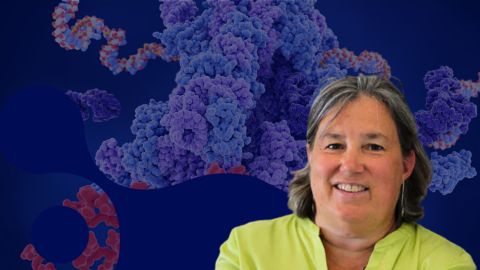Eczema Awareness Month
Eczema affects tens of millions of Americans, but it’s one of those conditions that is, in a way, hiding in plain sight. That is to say that eczema is so common that we don’t give it that much thought, and, at the same time, we don’t see it much because sufferers physically cover it up or stay home when the itch and discomfort make being out and about just plain miserable.
That’s why the National Eczema Association is using the month of October (Eczema Awareness Month) to campaign to #unhideEczema. The ASBMB is observing Eczema Awareness Month by sharing research and articles about the condition and skin health in general.
But before we get into that, here’s what you need to know about eczema:
Importantly, while we call it eczema, which makes it sound like it’s a single condition, it isn’t. It comes in a variety of forms.
The most common form is atopic dermatitis. People with atopic dermatitis often have a mutation in gene that makes the protein filaggrin. The condition also is closely tied to hayfever and asthma. We know both genetic and environmental factors are at play with atopic dermatitis.
Contact dermatitis, usually brought on by actually physically touching something to which you’re allergic, sometimes looks a lot like like atopic dermatitis but also can appear as hives. It’s not a chronic condition like atopic dermatitis, but it is definitely an allergic reaction..
Meanwhile, nummular eczema (also called discoid eczema or nummular dermatitis) looks quite different than the other forms of eczema. It’s not so much patchy but more round like ringworm. It seems to be inherited.
Seborrheic dermatitis is known as cradle cap in children, but it affects people of all ages. It’s usually is found on oily parts of the body (scalp, upper back, etc.) and seems to be tied to both genes and hormones.
Finally, there’s stasis dermatitis, which is also known as venous eczema or gravitational dermatitis. The redness and swelling of venous eczema is an indication of circulatory problems, usually in the lower legs, and tends to affect people over 50.
While it’s not surprising that eczema can present with other conditions relating to immune responses, such as asthma and hayfever, it’s worth mentioning that studies have found that eczema patients have higher rates of depression and anxiety than the rest of the population.
On the surface, this might make sense: If you’re covered in an itchy, unsightly or otherwise discomforting rash, that’s probably going to affect your mood. But, on a deeper level, the correlation underscores how important it is for researchers to learn more about the immune system, chronic inflammation, stress and the brain.
We hope you enjoy the collection of articles below.
Babies’ skin inspires eczema lotion: Newborns emerge from the womb covered with a waxy substance called the vernix, which protects their skin from drying. The vernix also helps babies adapt to life outside the womb by stimulating cells in the skin to make water-resistant lipid molecules. Scientists recently formulated a lotion based on lipids found in the vernix and tested it on the skin of healthy volunteers. Read about the study.
Disrupting the skin barrier: One problem central to eczema is disruption of the lipid barrier, a waxy coating that prevents outside irritants from getting under the skin. If researchers are going to understand how the lipid barrier breaks down in dermatitis and eczema, they need to know what it looks like in healthy skin. This paper from 2011 was an early foray into using analytical chemistry to identify lipids in human skin.
Vulnerable to secondary infections: People with eczema can also suffer secondary infections when bacteria grow on the broken skin. In healthy skin, antimicrobial lipids prevent such invasion. Learn more in this thematic review.
Inflammation and cancer: The skin is the body’s interface with the world and all its stressors, which means that dynamic processes of inflammation and damage control play out in skin cells. Researchers from several universities in Japan showed that an immune system phospholipase plays dual roles in inflammation and cancer. Mice lacking the enzyme had increased psoriasis and contact dermatitis, but less skin cancer. Read the study.
Just scratching the surface of itch: One of the classic symptoms of eczema is itchiness, but itch is one of the most poorly understood physiological sensations. Researchers at Duke University showed that TRPV4 ion channels, which are involved in a number of functions including pain sensing, are also involved in sensing itch. TRPV4 acted as an itch receptor in the context of histamine-induced itch, but not in response to histamine-independent itch stimuli. Read the study.
Enjoy reading ASBMB Today?
Become a member to receive the print edition four times a year and the digital edition monthly.
Learn moreGet the latest from ASBMB Today
Enter your email address, and we’ll send you a weekly email with recent articles, interviews and more.
Latest in Science
Science highlights or most popular articles

Targeting Toxoplasma parasites and their protein accomplices
Researchers identify that a Toxoplasma gondii enzyme drives parasite's survival. Read more about this recent study from the Journal of Lipid Research.

Scavenger protein receptor aids the transport of lipoproteins
Scientists elucidated how two major splice variants of scavenger receptors affect cellular localization in endothelial cells. Read more about this recent study from the Journal of Lipid Research.

Fat cells are a culprit in osteoporosis
Scientists reveal that lipid transfer from bone marrow adipocytes to osteoblasts impairs bone formation by downregulating osteogenic proteins and inducing ferroptosis. Read more about this recent study from the Journal of Lipid Research.

Unraveling oncogenesis: What makes cancer tick?
Learn about the ASBMB 2025 symposium on oncogenic hubs: chromatin regulatory and transcriptional complexes in cancer.

Exploring lipid metabolism: A journey through time and innovation
Recent lipid metabolism research has unveiled critical insights into lipid–protein interactions, offering potential therapeutic targets for metabolic and neurodegenerative diseases. Check out the latest in lipid science at the ASBMB annual meeting.

Melissa Moore to speak at ASBMB 2025
Richard Silverman and Melissa Moore are the featured speakers at the ASBMB annual meeting to be held April 12-15 in Chicago.
